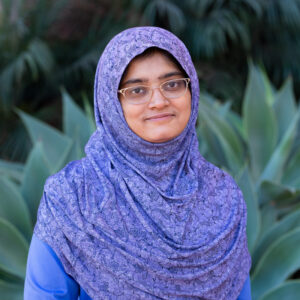Welcoming Esmat Farzana, new assistant professor of electrical and computer engineering
Author: Cyclone Engineering
Author: Cyclone Engineering
 Education: PhD, Electrical and Computer Engineering, The Ohio State University, 2019. BSc, Electrical and Electronic Engineering, Bangladesh University of Engineering & Technology, 2011
Education: PhD, Electrical and Computer Engineering, The Ohio State University, 2019. BSc, Electrical and Electronic Engineering, Bangladesh University of Engineering & Technology, 2011
Research focus: Investigating the existing challenges of emerging ultrawide-bandgap semiconductors (UWBG), including their device design, fabrication, and advanced defect characterization, which aims to improve their material properties, device performance, and extreme environment tolerance.
Joins Iowa State from: Postdoctoral research position, Materials Department, University of California, Santa Barbara
Recognitions and awards: Lead-author publications featured as editor’s pick in leading journals in the field, including IEEE Electron Device Letters, APL Materials, and Applied Physics Letters. Selected a Rising Star in EECS at UC Berkley in 2020. Invited by the American Institute of Physics (AIP) to be an editor for a book “Ultrawide Bandgap β-Ga2O3 Semiconductor: Theory and Applications“.
How do you hope your research discoveries impact the world?
My research broadly focuses on next generation energy-efficient power electronics by utilizing the unique properties of UWBG semiconductors. The current silicon-based power devices are no longer efficient to meet the requirements of emerging areas, such as electric vehicles, high-speed communication, data center, and smart grids. Hence, we need research into new class of semiconductors that can enable compact, low-loss, fast, and reliable power switches to address the grand challenges of global energy wastage and climate changes.
The UWBG semiconductors, such as β-Ga2O3 and III-nitrides, bring immense potential to revolutionize the power electronics industry with their superior intrinsic material properties than silicon. They allow significantly expanded voltage rating in a smaller device size, better thermal stability, and less energy waste – all enabling a greener economy. A UWBG transformation for power devices will drastically advance many technologies we use every day, from enabling fast chargers for our smartphone, laptops, and electric cars, to powerful supercomputers for quantum computing and big data analytics, to efficient grid-scale and renewable power systems. Additionally, their better radiation tolerance will directly benefit the critical space and defense electronics, such as satellites, radars, and sensors, with reliable power devices to operate under extreme radiation exposure.
However, the promise of the UWBG devices is yet to be fully harnessed in commercial power electronics. As still in their early stage, many UWBG devices need improvement in film quality, device design, and fabrication to achieve the expected current transport and voltage rating, which is often degraded due to undesirable defects and non-uniform high electric field distribution. The situation is more exacerbated when devices operate under extreme conditions, such as elevated temperature or heavy ion radiation, that severely limits the available power, voltage rating and operation lifetime.
The overarching goal of my research is to elucidate how UWBG semiconductor properties can be fully utilized into device functionality for each specific application area. Toward this vision, my research will perform a multi-disciplinary approach from materials to devices, bridging material quality improvement with new device design and fabrication, to adapt with the unique application challenges. This will certainly maximize UWBG device performance, reliability, yield, and accelerate their widespread adoption from lab to commercial production to enable global energy savings.
What kind of classroom and teaching experience do you look forward to creating at Iowa State?
I look forward to teaching both undergraduate and graduate level courses, particularly related to semiconductor materials, devices and fabrication. I will also bring my expertise to complement and extend the current curriculum with a new special topic course on “Wide-bandgap Semiconductors and Devices”. This area has intensive focus now with the potential of transforming almost every electronic industry in the world with superior power handling infrastructure.
In my courses, I plan to coordinate both classroom lectures and lab-based education, with a balance of fundamental concepts and research-based knowledge, that include TCAD device modeling and hands-on fabrication. I will also encourage undergraduate students to take up research projects in my lab that will prepare them for future graduate studies in this field. I feel right now, this is an exciting time to offer semiconductor education and training to future scientists and engineers, as envisioned in the CHIPS Act, for regaining US leadership and innovation in domestic semiconductor manufacturing.
What drew you to join Iowa State?
I am thrilled to join Iowa State because of the reputation of the ECpE program, and its depth and breadth of research in microelectronics, devices, circuits, to all the way to electric power and energy systems. Hence, there is a natural fit with my research area, as well as exciting opportunities for collaboration with faculties at ISU and Ames National Laboratory, to advance UWBG devices in power system and grid-level integration.
Iowa State also offers extensive facilities to advance my research. The Microelectronics Research Center has a dedicated Agnitron metal-organic chemical vapor deposition (MOCVD) reactor for β-Ga2O3 that enables an in-house capacity to grow device-quality films as well as pursue defect studies with relation to growth condition. The MRC and Materials Analysis and Research Laboratory also house state-of-the-art device fabrication and structural, optical and electronic characterization facilities. My laboratory will further add a unique UWBG defect spectroscopy system with thermal, optical and frequency-based defect modulation capabilities, to conduct precise defect characterization in UWBG semiconductors and power devices.
The reputation of the ECpE program at Iowa State also attracts brilliant students, from across the U.S. and the world, Hence, I will be able to form a strong research group with outstanding and motivated students, which is very important for a new faculty to initiate and develop a research program. Besides, Iowa State also has a great academic curriculum with both undergrad and grad level courses in semiconductor materials and devices. I am truly excited to explore the research and teaching opportunities at Iowa State to enrich the next step of my career.